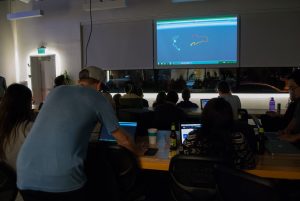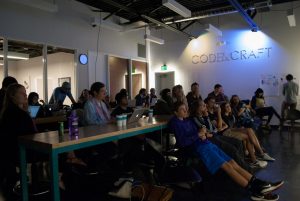By Ryan Kampmeier / NM News Port
With the flip of a switch, projection screens fall, hiding the Albuquerque sunset.
“Welcome to AGDG,” Ryan Leonski says, as he opens another weekly meeting of the Albuquerque Game Developers Guild, a weekly gathering of amateur and professional video game developers.
Soon the screens are filled with the latest inventions from Albuquerque game developers.
Kurt Hollowell, a UNM computer engineering graduate, shows his “mesh tracer tool,” which allows designers to draw in 3D space, even replicating their doodles symmetrically in any direction. The application can be used in conjunction with the Unity game engine, a tool many guild attendees use to create their games.
Hollowell is developing Stellar, a space shooter that changes the player’s point of view between 2D and 3D perspectives. His company is called Dog Eat Dog Games.

Leonski, the Guild moderator, presents the marketing tactics used to promote his game Sky Pets, planned for release on mobile devices. The tactics include emailing press releases to gaming publications and to YouTube personalities.
In an interview, Leonski said there are many benefits to the weekly meetings.
“What’s great about having a community is that it forms these connections, friendships, and rivalries. It really makes you want to push yourself harder,” Leonski said. “It really reinforces that there’s something happening.”
Leonski lists three goals for the guild, which is free to attend. He wants to introduce the video game industry to Albuquerque, help develop a tech culture in Albuquerque, and reach students who are interested in science, technology, engineering, and mathematics.
“It’s not just about growing games, it’s about growing tech also,” Leonski said.
Hollowell says a benefit of attending the guild is the technical advice that peers can offer.
“There’s micro tutorials people give — or sometimes someone is giving a demo — and it’s something I don’t know how to do — then it’s perfect. You just ask them and they’ll tell you. There’s a lot of people in here with a wide range of knowledge.”

Ian Burch, developer of Moonstrider, got his master’s degree in mathematics from UNM. He says the degree gave him scientific programming experience, but translating his knowledge to game programming hasn’t been perfect.
“You want to make a simulation of a bunch of neurons or a forest fire in MatLab, that’s a fundamentally different programming type than game development. For game development I’m almost entirely self-taught, which has definitely led to a few issues in development,” Burch said. “There’s plenty of other people that know general logical techniques, sound editing, art especially.”
Burch said the feedback he gets from the guild helps with motivation for the long task of developing his game. He compares it to the motivational boost he got when showing his game at Momocon, a convention in Georgia that celebrates video games, tabletop games, and animation.
“It’s such a cool feeling when you’re at this convention with like 40,000 people, so much crazy stuff to do and [larger-budgeted games] with stations and people are still coming back. People that came the first day are coming back every single day of the convention to play your game. That’s just such a cool feeling,” Burch said.
Hollowell agrees. “It gets me fired up to keep pushing myself further to see all these other people and the progress they’ve made. It makes me want to do better myself and also just find people to collaborate with and to help grow the community locally,“ Hollowell said.
Video: Meet some of the colorful characters who are bringing the gaming industry to New Mexico.
The AGDG hopes to pursue its goals with assistance from the city.
“We’ve spoken to Mayor Richard Berry. He has come to one of the meetings and we had a long, in-depth discussion and he’s willing to work with us. The thing for him, though, is that we need to have actionable goals that he can work with…That’s the thing that we’re still investigating now, especially as we’re trying to move into this next chapter of AGDG,” Leonski said.
The type of support that Leonski aims to achieve has been seen in areas like Ontario, Canada, where tax incentives give game companies financial reason to set up shop. The Ontario Media Development Corporation (OMDC) offers the Interactive Digital Media Fund to content creators, contributing up to 50 percent of a project’s budget, up to $300,000.
One hurdle in creating a game development community is the small size of the local industry and the limited number of paid jobs. As a result, there’s a tendency for qualified college graduates to take jobs at the national laboratories.
Hollowell has worked at Sandia Labs for more than four years, as an intern during college and contractor after graduation. Some projects he has worked on at Sandia have even included video games.
“I have done a few things there involving video games. Like one group, we extrapolated some data, like some log data basically taken from a space [massively multiplayer online] game and used that to try and predict behavioral trends,” Hollowell said.
In addition to their day jobs, many game developers look for other ways to find extra income to support their projects, like the mesh tracer tool Kurt Hollowell presented. Tools created for a game can sometimes be sold to other developers. Hollowell says he will put extra time into a tool for his game and write documentation for it if he thinks it could benefit other developers. ”A lot of times you’re making a game and then you have an idea for something that can be used different places,” Hollowell said.
Game developers may face other challenges while making their games. Hollowell struggled to fine tune the in-game camera that follows the player-controlled space ship. “I’ve refactored the camera like twenty times or something like that,” Hollowell said. “The game’s also procedurally generated, so that was a challenge too. But, it’s a good thing and a bad thing. It’s hard to get right, but if you do, then you can have infinite content out of a small set of assets.”
The Albuquerque Game Developers Guild meets at Levitated Toy Factory every Tuesday night from 6:30 to 9:00 p.m.
Follow Ryan on Twitter at @ryankampy.